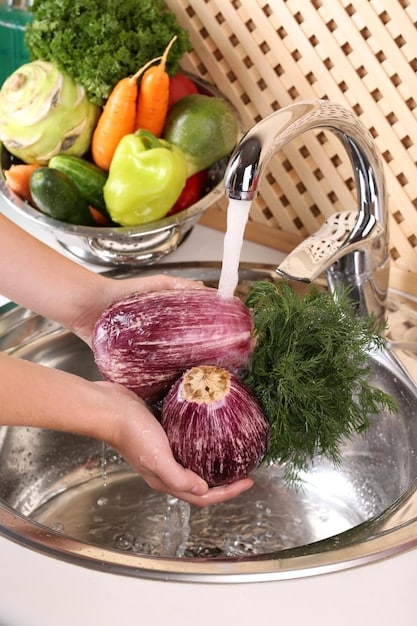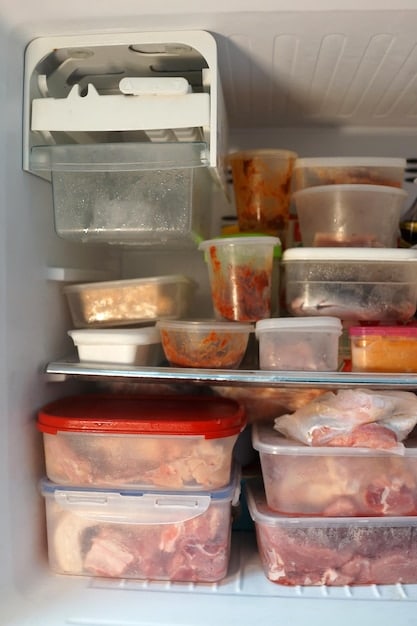Navigate Safe Eating: New US Guidelines for Home Food Handling

Understanding the New US Guidelines for Safe Food Handling at Home is crucial for preventing foodborne illnesses by focusing on four key steps: clean, separate, cook, and chill, ensuring families maintain a healthy environment when preparing and storing food.
Navigating the kitchen safely is essential to protect your family from foodborne illnesses. Understanding the New US Guidelines for Safe Food Handling at Home empowers you to make informed decisions and implement the best practices for preparing, cooking, and storing food.
Understanding the Core Principles of Safe Food Handling
The foundation of safe food handling rests on a few core principles that are universally applicable across various types of food and preparation methods. These principles are designed to minimize the risk of contamination.
Clean: Your First Line of Defense
Maintaining cleanliness is paramount. Washing hands and surfaces properly is a must. This reduces pathogens that can cause illness.
Separate: Avoid Cross-Contamination
Cross-contamination can easily occur if raw and cooked foods come into contact. It’s key to keep these items separate during preparation and storage.
- Use separate cutting boards for raw meats, poultry, seafood, and produce.
- Keep raw foods separate from cooked foods in the refrigerator.
- Wash utensils and surfaces thoroughly after contact with raw foods.

By consistently applying these principles, and maintaining a clean kitchen you are significantly reducing the risk of foodborne illnesses.
Decoding the Latest Guidelines: Key Updates
The US guidelines for safe food handling are periodically updated to reflect the latest scientific findings and best practices. Staying informed about these key updates is essential for ensuring the safety of your food supply at home.
Focus on Emerging Pathogens
Recent updates often address emerging pathogens that may pose new risks. These pathogens can be particularly dangerous due to their resistance to traditional food safety measures.
Enhanced Temperature Control
Maintaining accurate temperature control is the most effective way to prevent bacterial growth. It is important to be aware of the specific temperature requirements for different types of food.
- Use a food thermometer to ensure meats and poultry reach safe internal temperatures.
- Store perishable foods at or below 40°F (4°C) in the refrigerator.
- Keep hot foods hot, above 140°F (60°C), until served.
Staying up-to-date with guidelines helps consumers adopt safer kitchen practices and safeguard their health effectively.
Mastering the Four Key Steps: Clean, Separate, Cook, Chill
The core of the safe food handling guidelines can be distilled into four essential steps: clean, separate, cook, and chill. Each of these steps plays a vital role in preventing foodborne illnesses.
Clean: Handwashing and Surface Sanitation
Proper handwashing is the cornerstone of food safety. This simple action can drastically reduce the spread of germs.
Separate: Preventing Cross-Contamination
Avoiding cross-contamination is crucial to prevent the transfer of harmful bacteria from raw foods to cooked or ready-to-eat foods.

Cooking Food to Safe Internal Temperatures
Cooking food to the correct internal temperature is essential for killing harmful bacteria and viruses that can cause foodborne illnesses. A food thermometer is your best tool in achieving this.
Importance of Using a Food Thermometer
Internal temperature is essential. Eyeing up whether the meat is cooked is now allowed. A food thermometer is essential to ensure safety regarding meat, poultry and fish.
Safe Temperatures for Different Foods
- Poultry: 165°F (74°C)
- Ground Meats: 160°F (71°C)
- Steaks, Chops, Roasts: 145°F (63°C)
Cooking to safe temperatures is a critical step in ensuring that meals are safe.
The Importance of Proper Refrigeration and Chilling
Proper refrigeration is one of the most important steps to preventing foodborne illnesses. Chilling slows down the growth of bacteria.
Understanding the Danger Zone
The “danger zone” is the temperature range between 40°F (4°C) and 140°F (60°C) where bacteria like to grow.
Best Practices for Refrigeration and Freezing
Cool food promptly and store properly to reduce the growth of bacteria.
- Refrigerate or freeze perishable foods within two hours of cooking or purchasing.
- Never thaw food at room temperature; use the refrigerator, cold water, or microwave.
- Ensure your refrigerator is set to 40°F (4°C) or below.
By following these practices, you can keep food safe and prevent bacterial contamination.
Navigating Food Recalls: Staying Informed and Taking Action
Food recalls are issued when a food product is found to be unsafe or potentially harmful to consumers. Staying informed about food recalls and knowing how to respond is essential for protecting your health.
Sources for Food Recall Information
Multiple sources will notify consumers of food recalls and how to handle any recalled products!
Steps to Take During a Food Recall
If food is recalled you must take action. Return or throw out the product. Clean any surfaces the food touched!
| Key Point | Brief Description |
|---|---|
| 🧼 Proper Handwashing | Wash hands thoroughly with soap and water for at least 20 seconds before and after handling food. |
| 🔪 Separate Cutting Boards | Use separate cutting boards for raw meats, poultry, and seafood to prevent cross-contamination. |
| 🌡️ Use a Food Thermometer | Ensure meats and poultry reach safe internal temperatures by using a food thermometer. |
| 🧊 Proper Chilling | Refrigerate perishable foods within two hours to prevent bacterial growth. |
Frequently Asked Questions
▼
Handwashing is crucial as it removes germs that can cause foodborne illnesses. Washing hands before, during, and after food preparation helps prevent the spread of bacteria to food.
▼
Cross-contamination occurs when harmful bacteria are transferred from one food (especially raw meats) to another. This can lead to illness if the contaminated food is eaten without proper cooking.
▼
The safe internal temperature for cooking chicken is 165°F (74°C). Using a food thermometer ensures the chicken is cooked thoroughly to kill harmful bacteria.
▼
Food should be refrigerated within two hours to slow down the growth of bacteria. Bacteria multiply rapidly at room temperature, increasing the risk of foodborne illness.
▼
You can stay informed about food recalls by checking the FDA and USDA websites, signing up for email alerts, and monitoring news outlets. Prompt action can prevent illness from recalled products.
Conclusion
Safe food handling at home is a crucial aspect of daily life in the US. By understanding the New US Guidelines for Safe Food Handling at Home through implementing these guidelines and staying informed, households can enhance their family’s safety and well-being!





